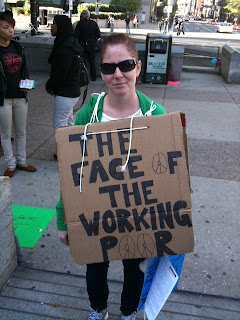| Stacey in Philadelphia |
In reflection of President Obama’s State of the Union last
week, the issue of fairness was a prevailing theme. This theme has often been painted with
slogans such as “class warfare” or “redistributing the wealth”, but when we dig
deeper behind the meaning of fairness, we can see that it really is about
access to opportunity.
It is a common statement in the field of public health that
the “less you have, the more you have”.
In other words, those from lower economic means have a greater
prevalence of disease and disability.
The poor have a tendency to live in crowded or environmentally toxic
living conditions with substandard housing and are less likely to have access
to healthy food. In fact, the poor
disproportionately live in areas we dub “food deserts”, regions in which
affordable healthy food and transportation to them is lacking. It also shouldn’t be a surprise that the
working poor are also disproportionately represented among the pool of the
uninsured, therefore exponentially increasing their prevalence of disease and
disability. Finally, the poor live in
areas with a low tax base resulting in substandard education that leads to lack
of awareness concerning health issues and opportunities to rise beyond their
current social status.
My travels across Pennsylvania have certainly shown many things
about our healthcare crisis.
Our changing global economy with its evolution from manufacturing jobs
to service sector jobs has taken its toll on the working class. Between 1980-2007, the number of Americans
with access to employer provided healthcare has drastically declined.[1] The need for cheap labor has meant increase
in low wage jobs with little or no benefits.
In other words, there has been a lack of opportunity for the working class
to achieve economic social mobility which guarantees protections and security
in the area of health.
In the Fall of 2011 I became intrigued by what I saw
emerging in the national landscape and ongoing dialogue about economic
inequality as the “Occupy Wallstreet” movement unraveled across the
country. Being aware of what I have come
to call the “Health/Wealth gap”, I was certain that this national dialogue
about economic inequality had to encompass those that have been shut out of
access to healthcare.
With this in mind, in mid-October I hit the road and headed to Philladelphia to join an “Occupy Philly” rally to see what I could find. I had no idea what to expect and the day I went I only had enough change to plug my parking meter for 2 hours. It only took 10 minutes before I met Stacey, a full-time employed nurse and mother of two. I spent those 2 hours talking to Stacey and documented her story. For the next 2 weeks I will tell her story that goes back 2 generations, beginning with her parents.
[1]
Cohen RA, Mukuc DM, Bernstein AB, Billheimer LT, Powell-Griner E. Health
Insurance coverage trends, 1959-2007: Estimates from the National Health
Interview Survey. National halth statistics reports; no 17. Hyattsville,
MD: national Center for Health
Sttistics. 2009.

No comments:
Post a Comment